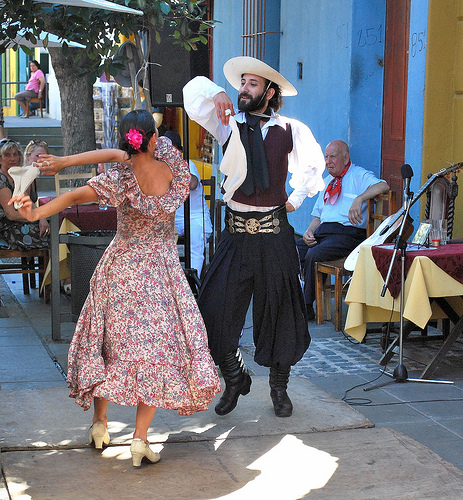Zamba (artform) on:
[Wikipedia]
[Google]
[Amazon]
 Zamba is a traditional dance of
Zamba is a traditional dance of
Strum guitar for Zamba
Boleadora.com
Argentine styles of music Argentine dances Dance in Argentina Native American dances {{folk-dance-stub
 Zamba is a traditional dance of
Zamba is a traditional dance of Argentina
Argentina (), officially the Argentine Republic ( es, link=no, República Argentina), is a country in the southern half of South America. Argentina covers an area of , making it the second-largest country in South America after Brazil, th ...
. It is a style of Argentine music
The music of Argentina includes a variety of traditional, classical and popular genres. One of the country's most significant cultural contributions
is the tango, which originated in Buenos Aires and its surroundings during the end of the 19th ce ...
and Argentine folk dance. Zamba is very different from its homophone
A homophone () is a word that is pronounced the same (to varying extent) as another word but differs in meaning. A ''homophone'' may also differ in spelling. The two words may be spelled the same, for example ''rose'' (flower) and ''rose'' (p ...
, the samba
Samba (), also known as samba urbano carioca (''urban Carioca samba'') or simply samba carioca (''Carioca samba''), is a Brazilian music genre that originated in the Afro-Brazilian communities of Rio de Janeiro in the early 20th century. Havin ...
- musically, rhythmically, temperamentally, in the steps of the dance and in its costume. It has six beats to the bar and is a majestic dance, performed by couples who circle each other waving white handkerchief
A handkerchief (; also called a hankie or, historically, a handkercher or a ) is a form of a kerchief or bandanna, typically a hemmed square of thin fabric which can be carried in the pocket or handbag for personal hygiene purposes such as wi ...
s very elegantly. It has common elements with the cueca.
Zambas are composed about many themes, from those that celebrate people or events of Argentine history
The history of Argentina can be divided into four main parts: the pre-Columbian time or early history (up to the sixteenth century), the colonial period (1536–1809), the period of nation-building (1810–1880), and the history of modern Argenti ...
, to those that describe the beauty of a region, or of its women. There are zambas of political protest, and even one called ''Aerolíneas Argentinas
Aerolíneas Argentinas, formally Aerolíneas Argentinas S.A., is Argentina's largest airline and the country flag carrier. The airline was created in 1949 from the merger of four companies and started operations in . A consortium led by Iberia ...
''. The ''bombo legüero
Bombo legüero is an Argentine drum traditionally made of a hollowed tree trunk and covered with cured skins of animals such as goats, cows (leather) or sheep; ''legüero'' signifies that you can supposedly hear it a league away. It derives from t ...
'' drum is prominent in the playing of the zamba.
Name and origin
The name "zamba" refers to a colonial term forzambo
Zambo ( or ) or Sambu is a racial term historically used in the Spanish Empire to refer to people of mixed Indigenous and African ancestry. Occasionally in the 21st century, the term is used in the Americas to refer to persons who are of mixe ...
(people that are descendants of Amerindian
The Indigenous peoples of the Americas are the inhabitants of the Americas before the arrival of the European settlers in the 15th century, and the ethnic groups who now identify themselves with those peoples.
Many Indigenous peoples of the Am ...
and African people
The population of Africa has grown rapidly over the past century and consequently shows a large youth bulge, further reinforced by a low life expectancy of below 50 years in some African countries. Total population as of 2020 is estimated at ...
). It is therefore called zamba because its lyrical content was aimed at its native listeners.
The dance originated in the Argentine province of Salta in the Creole genre known as the zamacueca of Peru
, image_flag = Flag of Peru.svg
, image_coat = Escudo nacional del Perú.svg
, other_symbol = Great Seal of the State
, other_symbol_type = Seal (emblem), National seal
, national_motto = "Fi ...
, in 1824 at the same time that Peru
, image_flag = Flag of Peru.svg
, image_coat = Escudo nacional del Perú.svg
, other_symbol = Great Seal of the State
, other_symbol_type = Seal (emblem), National seal
, national_motto = "Fi ...
, under José de San Martín
José Francisco de San Martín y Matorras (25 February 177817 August 1850), known simply as José de San Martín () or '' the Liberator of Argentina, Chile and Peru'', was an Argentine general and the primary leader of the southern and cent ...
, obtained independence. It came to Argentina through "Alto Peru," a region that is modern day Bolivia
, image_flag = Bandera de Bolivia (Estado).svg
, flag_alt = Horizontal tricolor (red, yellow, and green from top to bottom) with the coat of arms of Bolivia in the center
, flag_alt2 = 7 × 7 square p ...
and through Chile between 1825 and 1830.
Description
The Zamba is a slow dance in three-quarter time played primarily on guitar andbombo legüero
Bombo legüero is an Argentine drum traditionally made of a hollowed tree trunk and covered with cured skins of animals such as goats, cows (leather) or sheep; ''legüero'' signifies that you can supposedly hear it a league away. It derives from t ...
. The steps of the dance are a walking step, an alternate step (two steps at one time), and a tip toe alternate step or "sobrepaso punteado" (three steps at one time). The Zamba also requires a handkerchief.
References
External links
*Strum guitar for Zamba
Boleadora.com
Argentine styles of music Argentine dances Dance in Argentina Native American dances {{folk-dance-stub